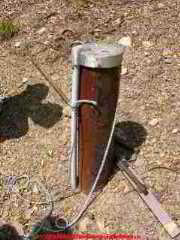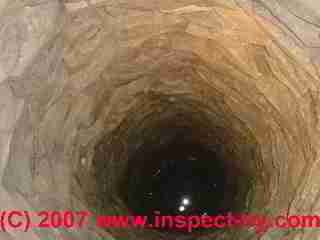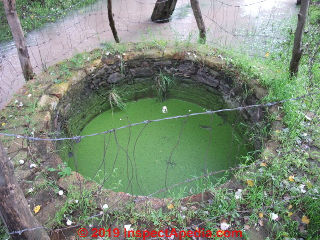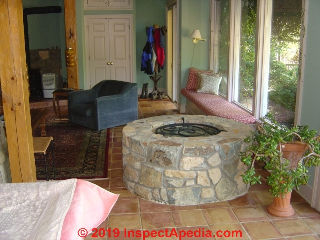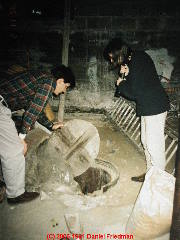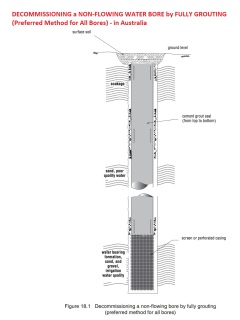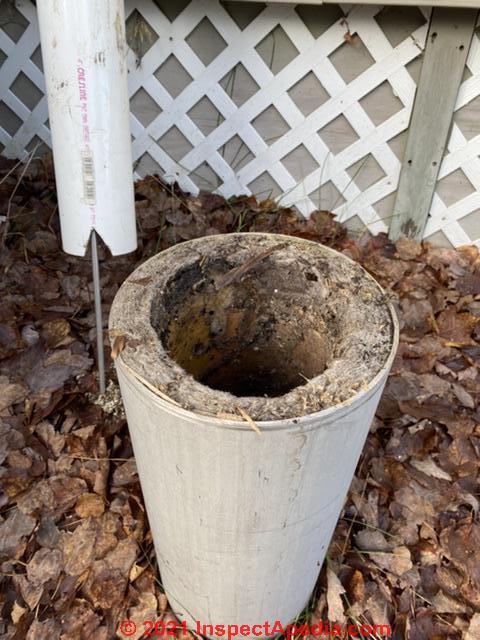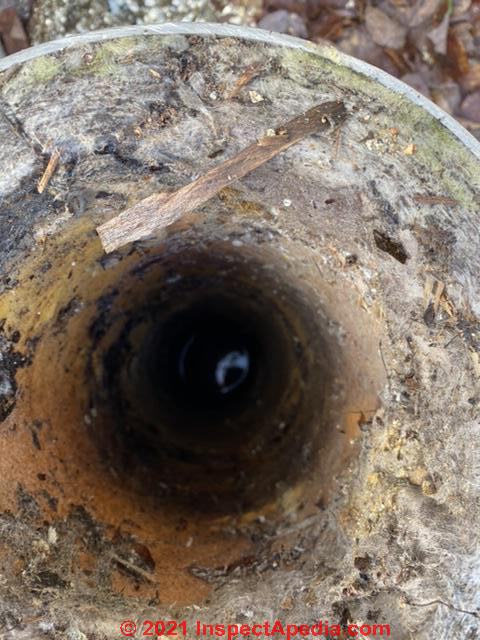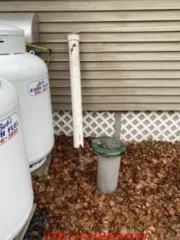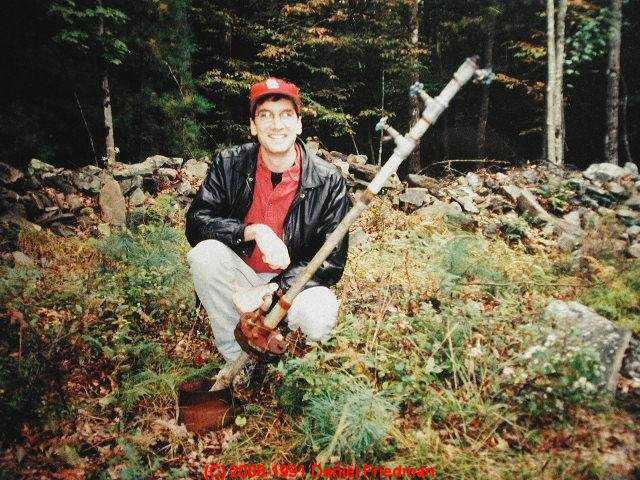 How to Abandon a Well
How to Abandon a Well
Procedures for decommissioning a drilled well,
bore hole, or dug well safely
- POST a QUESTION or COMMENT about how to abandon or decommission a drilled well, dug well, bore hole well, or driven well
How to decommission or abandon a water well:
We include recommendations for abandoning a drilled water well or borehole that will no longer be used and we provide research citations on proper well sealing or abandonment procedures.
In a second discussion we describe the procedure for abandoning a dug well.
The article includes research and regulation citations on water well or bore hole abandonment or decommissioning and adds warnings about practical problems that may occur during well abandonment.
InspectAPedia tolerates no conflicts of interest. We have no relationship with advertisers, products, or services discussed at this website.
- Daniel Friedman, Publisher/Editor/Author - See WHO ARE WE?
Well Abandonment / Bore-hole Sealing Procedures for Wells Taken out of Service
A well that is not in use-or sometimes referred to as an "abandoned" well - can be a potential threat to health, safety and the environment.
This article discusses proper abandonment or decommissioning of un-used or failed water wells of all types, including drilled wells and dug wells such as those shown in our photographs here.
Wells that are no longer used may be buried or forgotten.
Without proper abandonment such wells are unsafe: people, children, pets or other animals stepping into or falling into a borehole well or a dug well can be fatal. And even if protected by a cover, if abandoned wells are not filled-in they can contaminate the environment, polluting nearby drinking water sources.
Often they have not been sealed properly. Sealing is the process of clearing an unused well of debris and filling the well with a special material called grout. - various citations below.
The steps you need to take to seal off a water well or to de-commission a well depend on
- The type of well: drilled or bore-hole vs. dug well
- The well depth
- Whether the well decommissioning is temporary or permanent.
- Local regulations or laws that pertain where you live
[Click to enlarge any image]
Reader Question: how to shut down a well - how to abandon a well
 (May 3, 2012) Mark said:
(May 3, 2012) Mark said:
what's the best way to shut down a well. I mean to fill it with sand or concrete. ?
Reply: Abandoning a drilled well, bore hole, with steel casing
To *properly* abandon a drilled water well or bore hole well (such as a well with a steel casing) usually means
- Remove the well piping, pump, wiring, etc. from the well casing.
- Divert surface runoff away from the well.
- Disinfect the well? Hire a Pro?
Depending on regulations where you live you may be required to disinfect the well and also you might be required to hire a certified or licensed well professional.
The example comment below is excerpted from Washington State's DOE instructions in the U.S. A.
You will need to contact a licensed well driller to decommission a well. Washington law requires all wells be decommissioned by a licensed driller.
A licensed driller will have experience with well construction and decommissioning materials and methods. They also know about the local geology. All of this knowledge is necessary to safely and properly close a well.
Costs to decommission wells will vary depending on the depth, diameter , and geology of the area.
Special equipment may be required to remove old pumps and pipes from the well. You will need to send in a “Notice of Intent to Decommission a Well” to the Department of Ecology at least 72 hours in advance of the work. - Washington State DOE, retrieved 31 Jan 2015 original source: https://fortress.wa.gov/ecy/publications/publications/96br097.pdf
Watch out: the amount of bleach actually needed to disinfect a well depends on the actual volume of water in th well - which is a function of the well water total depth and well diameter.
See WELL CHLORINATION SHOCKING PROCEDURE
and
See WELL DYNAMIC HEAD & STATIC HEAD DEFINITION - how to calculate the amount of water in a well.
A general guide using laundry bleach (5.25% chlorine) is to use 3 cups of bleach per 100 gallons of well water.
If you are using hypochlorite granules (70% chlorine) you can use 2 heaping table spoons per 100 gallons of well water, pre-mixed and then poured into the well, washing down casing sides in the process.
Also take care that handling bleach itself is dangerous and requires appropriate caution and protective gear. - Seal the well to be abandoned.
There may be alternative methods that are acceptable depending on local regulations, well depth, casing condition, etc. such as using a plug in the casing for deep wells but there are concerns with plug failure: analyzed by Mainguy (2007) and Jiminez (2002).
Generally the well company will fill in the well with concrete or with bentonite clay or another grouting material to be sure that surface water or casing leaks never inject contaminants into the aquifer via the well bore. Don't use sand as that won't prevent surface runoff or other contaminants from entering the well.
Well plugging material details: well plugging materials commonly used include "neat cement" (6 gallons of water per 94 pond bag of cement), bentonite clay slurry used for commercial grouting or plugging bentonite, or pelletized or crushed bentonite: pellets or chips of bentonite clay that will swell (to 10x original volume) when wet. If using bentonite chips use larger coarse product (3/8 to 3/4 ") that will pour well into the well casing.
For a 6-inch well casing you'll need about 15 pounds of coarse bentonite clay filler per foot of well depth.
Watch out: if your well plugging material is not successfully poured to the bottom of the well you may be required to bore out the whole mess and do the job over again. Pour materials slowly and be sure they are falling to the well bottom.
Some jurisdictions require that the well casing top of a decommissioned well should be welded in place or sealed by a threaded or mechanically attached water-tight cap. - Cut off the casing?
Some jurisdictions require that after shocking and sealing the well the casing should be cut off and then capped below ground, typically at 2 feet. The hole or well pit if a well-pit is involved, is then back-filled. - Record the well location (opinion)
- Report the well decommissioning as required by local codes.
How to Abandon a Hand Dug Well
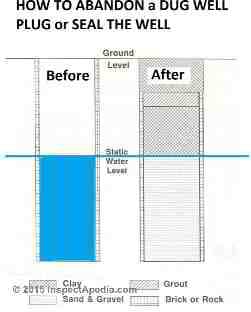 Hand dug wells (and large bore hole wells) present both the risk of contamination of the aquifer by surface runoff and the risk of personal hazard should someone fall into the well.
Hand dug wells (and large bore hole wells) present both the risk of contamination of the aquifer by surface runoff and the risk of personal hazard should someone fall into the well.
Dug wells, too, if not to be used, should be safely and properly abandoned. However depending on its original construction (such as dry stone laid well wall) it may be difficult to assure that surface water won't run into the well excavation.
The following dug well abandonment advice is adapted from the Kansas Department of Public Health in the U.S. Check with your local government as other regulations may apply at your location.
- Find the high water level: Measure the water level in the well with a weighted tape measure or string. If marks in the well indicate that water levels have been higher than present, use the higher water level.
See WELL DEPTH, HOW TO MEASURE - Disinfect the well: Pour approximately two gallons of chlorine bleach into the well to properly disinfect it.
Watch out: this DOH advice is not entirely reliable as the amount of bleach actually needed to disinfect a well depends on the actual volume of water in th well - which is a function of the well water total depth and well diameter.
See WELL CHLORINATION SHOCKING PROCEDURE
and
See WELL DYNAMIC HEAD & STATIC HEAD DEFINITION - how to calculate the amount of water in a well - Knock down the top five feet of the well wall
material and let it fall inside the well. - Fill the well with sand and gravel to the water level top
which was measured in Step 1 above (the blue line in our sketch). Use the weighted string or tape measure to determine when enough san and gravel have been added.
Above: the first dug well shown above, located in Mexico, has been filled in to about 12 inches above the surface of surrounding soil (and concrete).
Our second photo, below, of a well in Tlaxcala, Mexico, has not been abandoned nor is there a protective cover.
- Fill in the remaining open space with compacted natural clay or approved grout to a depth of 5 feet below ground surface.
- Use approved cement or sodium bentonite and sodium bentonite grouting material to fill
the well from 5 feet to 4½ feet below ground surface.
Watch out: if the well excavation at the end of this step is a fall-in hazard to anyone and considering that in step 7 we are to wait for the bentonite to cure, it may be necessary to set up appropriate guards or barriers to prevent an accident. Washington State's DOE reported:
There have been no reported deaths of people falling into abandoned wells in recent years in Washington state but just about every year there are reports of dogs, horses or other farm animals injured or killed from a fall into an abandoned well.
In August 2012, a 1,800-pound horse fell into an abandoned well in Centralia and died after a rescue attempt by local firefighters.
The horse had stepped on top of a concrete lid that covered the top of the well, which collapsed underneath the horse’s weight. In July 2012, a 13-year-old pet draft horse fell through a covering on an abandoned well near Shelton but was able to keep his head above water until fire department rescuers were able to pump the water from the well and pull him free.
Dogs have died or have been injured in recent years on Vashon Island and near Chehalis. Photo of worker climbing down an abandowned well. Courtesy of Riverside Fire Authority Note that abandoned wells cannot be used for animal carcass disposal. - retrieved 31 Jan 2015 original source: http://www.ecy.wa.gov/programs/wr/wells/abandon-wells.html - Backfill the remaining well depth: after a proper amount of time to allow for the curing of the grouting material, back fill the remaining part of the well with surface soils all the way to the surface.
- Report the plugging of the well as required by your local authorities. For example Kansas requires a plugging record to be filed with the KDHE Bureau of Water - Geology Section.
Portions of this article are adapted from Kansas DOH: "How do I Plug a Dug Well - Fact Sheet", Kansas Department of Heatlh and Environment, cited in detail below, and from other sources cited below.
Must an Un-Used Well Always be Abandoned by Filling In?
Well perhaps not, particularly if there is some chance that the well may be needed in the future, but at the very least the well needs a safe and secure cover.
It's not uncommon to find old dug wells that end up inside of a building, usually because new construction expanded the building to surround the old well, or less-common, because a well was dug in the basement of a home.
Both of these situations are shown in our photos below. The well in the livingroom photo (above) was contributed by InspectApedia.com reader GW. Notice that a safety grille (somewhat too open in my OPINION) has been isntalled.
The flimsy wood cover over the dug well in the basement of the New York home shown below was unsafe and, of course, nothing protected the santiation of the well against basement water entry - a common problem in the area.
References & research on proper well abandonment procedures
Illustration: Decommissioning water bore holes by fully grouting is the preferred method for abandoning a non-flowing or out-of-use bore in Australia - cited just below.
[Click to enlarge any image]
- Akgün, H. "An assessment of borehole sealing performance in a salt environment." Environmental Geology 31, no. 1-2 (1997): 34-41.
- Arkansas PROPER CARE of UNUSED WELLS [PDF] Arkansas Water Well Construction Commission
101 East Capitol, Suite 350
Little Rock, AR 72201
(501) 682-3900 Fax: (501) 682-3991
http://www.arkansas.gov/awwcc/ retrieved 2019/09/13 original source: https://static.ark.org/eeuploads/anrc/Unused-Well-Handout.pdf
Excerpt: A well that is not in use-or sometimes referred to as an "abandoned" well - can be a potential threat to health, safety and the environment. Wells that are no longer used may be buried or forgotten.
Often they have not been sealed properly. Sealing is the process of clearing an unused well of debris and filling the well with a special material called grout.
Owners may seal their own well; however, the Commission strongly recommends that the sealing be done by a licensed well contractor. Unused wells that have not been properly sealed can be a source of ground water contamination, potentially affecting nearby drinking water wells. They may threaten the quality of the water in city water wells; your neighbor’s well, or even your own well.
Over 175,000 families in Arkansas get their source of drinking water from ground water obtained from privately owned wells. Over 400 public water supply systems utilize ground water as a primary supply of water and thousands of others utilize ground water for hotels, restaurants, schools, churches, and industrial applications. - Australia, MINIMUM CONSTRUCTION REQUIREMENTS for WATER BORES in AUSTRALIA [PDF] (2012) Version 3, Australian Government, National Water Commission, retrieved 2019/09/13 original source: https://www.water.wa.gov.au/__data/assets/pdf_file/0005/1796/Minimum-construction-guidelines-for-water-bores-in-Australia-V3.pdf
Excerpt: Deteriorated or abandoned bores that threaten the groundwater resource should be decommissioned in such a way that the hydrogeological environment is maintained or is returned as near as possible to the condition that existed before drilling. - Australia, NSW ABANDONED WELLS, (2014) Independent Review of Coal Seam Gas Activities in NSW Information paper: Abandoned wells New South Wales Government Chief Scientist & Engineer, original source: https://www.chiefscientist.nsw.gov.au/__data/assets/pdf_file/0009/56925/141002-Final-Abandoned-Well-report.pdf
See chapter 18: Bore Decommissioning "Failed or unwanted bores should be decommissioned to restore, as far as possible, the aquifer isolation that existed before the bore was drilled and constructed. " - Barclay, Ian, Jan Pellenbarg, Frans Tettero, Jochen Pfeiffer, Harold Slater, Timo Staal, David Stiles, Geoff Tilling, and Chris Whitney. "The beginning of the end: a review of abandonment and decommissioning practices." Oilfield Review 13, no. 4 (2001): 28-41.
- Brush, Richard E. "Wells Construction. Hand Dug and Hand Drilled. Appropriate Technologies for Development. Manual M-9." (1982).
- California, NAPA COUNTY WELL DESTRUCTION GUIDELINES [PDF] County of Napa, California, retrieved 2019/09/13 original source: https://www.countyofnapa.org/DocumentCenter/View/3924/Well-Destruction-Guidelines-PDF?bidId=
Excerpt:
“Well destruction” means certain work done to an existing well, the intent of which is to effectively seal the entire well up to the ground surface, in such a manner that each intersected water stratum is sealed and isolated from every other stratum and from surface water.
Destruction of wells shall be completed in accordance with the procedures outlined in Article IV of this division or as otherwise specified by the director. - Canada, Alberta, PLUGGING ABANDONED WELLS [PDF] Alberta Canada Government, AGRIC, retrieved 2019/09/13 original source: https://www1.agric.gov.ab.ca/$department/deptdocs.nsf/all/wwg414/$file/waterwells_Module9.pdf?OpenElement
- Canada, British Columbia, BEST PRACTICES for DECOMISSIONING WATER SUPPLY WELLS [PDF] BC Canada Government, retrieved 2019/09/13 original source: https://www2.gov.bc.ca/assets/gov/environment/air-land-water/water/water-wells/bc_gov_best_mgmt_practices_well_decomission.pdf
Excerpt: The Water Sustainability Act (the Act) and Groundwater Protection Regulation (GWPR) state that unused wells that have no plans for future use must be decommissioned. Unused wells intended for future use must be deactivated. - Canada: Ontario, WELL ABANDONMENT: HOW TO PLUG & SEAL A WELL [PDF] TEchnical Bulletin, 9 steps to abandon a well properly, Ontario Canada retrieved 2019/09/13 original source: https://www.ontario.ca/page/wells-regulation-well-abandonment-how-plug-and-seal-well-technical-bulletin
Excerpts:
The purpose of this technical bulletin is to summarize the information on how to abandon a well found in the Water Supply Wells Requirements and Best Management Practices manual published by the Ministry of the Environment and Climate Change.
To determine if a well needs to be abandoned, well owners should refer to Regulation 903 (Wells Regulation), as amended made under the Ontario Water Resources Act and the Wells Regulation Well Abandonment: When to Plug & Seal a Well technical bulletin. - Cunningham, Alfred B., Ellen Lauchnor, Joe Eldring, Richard Esposito, Andrew C. Mitchell, Robin Gerlach, Adrienne J. Phillips, Anozie Ebigbo, and Lee H. Spangler. "Abandoned well CO2 leakage mitigation using biologically induced mineralization: current progress and future directions." Greenhouse Gases: Science and Technology 3, no. 1 (2013): 40-49.
- Escolero, O. A., L. E. Marin, B. Steinich, A. J. Pacheco, S. A. Cabrera, and J. Alcocer. "Development of a protection strategy of karst limestone aquifers: the Merida Yucatan, Mexico case study." Water Resources Management 16, no. 5 (2002): 351-367.
- Gass, Tyler E., Jay H. Lehr, and Harold W. Heiss. Impact of abandoned wells on ground water. Environmental Protection Agency, Office of Research and Development, Robert S. Kerr Environmental Research Laboratory, 1977.
- Handbook of suggested practices for the design and installation of ground-water monitoring wells. National Water Well Association, 1989.
- Hou, Zhengmeng, Lars Wundram, Robert Meyer, Meinhardt Schmidt, Steffen Schmitz, and Patrick Were. "Development of a long-term wellbore sealing concept based on numerical simulations and in situ-testing in the Altmark natural gas field." Environmental Earth Sciences 67, no. 2 (2012): 395-409.
- Illinois ILLINOIS WATER WELL DECOMMISSIONING (WDP) [PDF] retrieved 2019/09/13 original source: http://www.kanedupageswcd.org/pdfs/Forms/WellSealingApplicationFY10.pdf
- Jimenez, J. A., and R. J. Chalaturnyk. "SPE/ISRM 78196." (2002).
- HOW DO I PLUG A DUG WELL? - Fact Sheet [PDF] Kansas Department of Heatlh and Environment, - retrieved 31 Jan 2015 original source: http://www.kdheks.gov/waterwell/download/PluggingHandDugWellsFactSheet.pdf
- Kopp, Andreas, Philip John Binning, K. Johannsen, R. Helmig, and H. Class. "A contribution to risk analysis for leakage through abandoned wells in geological CO 2 storage." Advances in Water Resources 33, no. 8 (2010): 867-879.
- Lapham, Wayne W., Franceska D. Wilde, and Michael T. Koterba. Guidelines and standard procedures for studies of ground-water quality: selection and installation of wells, and supporting documentation. US Department of the Interior, US Geological Survey, 1997.
- Mainguy, M., P. Longuemare, A. Audibert, and E. Lécolier. "Analyzing the risk of well plug failure after abandonment." Oil & Gas Science and Technology-Revue de l'IFP 62, no. 3 (2007): 311-324.
- Minnesota DOH, SEALING UNUSED WELLS [PDF] Minnesota Department of Health, retrieved 2019/09/13 original source: https://www.health.state.mn.us/communities/environment/water/wells/sealing/abandwel.html
Excerpt: Every unused well that is not properly sealed poses a safety, health, and environmental threat to your family and community as well as a potential legal risk to the homeowner.
If the well is not in use and does not have a Water Well Maintenance Permit, or the well poses a threat to health or safety, Minnesota law requires that you must have the well sealed. If your well appears to be filled or capped, but you learn it was improperly sealed, the homeowner is responsible to have the well properly sealed by an MDH licensed well contractor. - MO, ABANDONED WELLS: LOCATING, PLUGGING AND REPORTING - PUB2900 [PDF] Missouri Department of Natural Resources, Geological Survey Program,
111 Fairgrounds Road
PO Box 250
Rolla, MO 65402-0250
United States
Toll-free
800-361-4827
Email
geology@dnr.mo.gov - retrieved 2022/07/16 original source: https://dnr.mo.gov/document-search/ abandoned-wells-locating-plugging-reporting-pub2900/pub2900
Excerpt:
Abandoned wells can present a physical hazard and threat to groundwater. Hand-dug wells with wide openings pose a life-threatening hazard to people and animals. Abandoned wells that reach deep into groundwater aquifers serve as a conduit for contamination. - Nagelhout, A. C. G., M. G. R. Bosma, P. J. Mul, G. G. Krol, J. F. G. van Velzen, J. S. Joldersma, S. G. James, B. Dargaud, G. J. R. Schreuder, and F. Théry. "Laboratory and Field Validation of a Sealant System for Critical Plug-and-Abandon Situations." SPE drilling & completion 25, no. 3 (2010): 314.
- New Jersey DEP N.J.A.C. 7:9D WELL CONSTRUCTION AND MAINTENANCE; SEALING OF ABANDONED WELLS [PDF] New Jersey DEP, retrieved 2019/09/13 original source: https://www.nj.gov/dep/rules/rules/njac7_9d.pdf
- New York DOH, DECOMMISSIONING ABANDONED WELLS [PDF] New York State Department of Health, retrieved 2019/09/13 original source: https://www.health.ny.gov/environmental/water/drinking/regulations/fact_sheets/fs4_abandoning_wells.htm
Excerpt: Drinking water wells and other types of wells that are no longer in use can pose safety hazards, especially to small children and pets. These abandoned wells can also serve as pathways for contamination to enter groundwater. Abandoned wells should be properly decommissioned to eliminate these potential hazards. - Pennsylvania DEP, WELL ABANDONMENT PROCEDURES [PDF] Pennsylvania Department of Envrionmental Protection, retrieved 2019/09/13, original source: https://www.dep.state.pa.us/dep/deputate/watermgt/Wc/Subjects/SrceProt/ground/sympos/GrdMonitor-chap7.htm
Excerpt:
Unsealed or improperly sealed wells may threaten public health and safety, and the quality of the groundwater resources. Therefore, the proper abandonment (decommissioning) of a well is a critical final step in its service life. Act 610, the Water Well Drillers License Act, includes a provision for abandonment of wells.
This legislation makes it the responsibility of a well owner to properly seal an abandoned well according to the rules and regulations of the department. In the absence of more stringent regulatory standards, the procedures outlined in this section represent minimum guidelines for proper abandonment of wells and borings.
These procedures may be applicable for, but not limited to, public and domestic water supply wells, monitoring wells, borings or drive points drilled to collect subsurface information, test borings for groundwater exploration, and dry wells (drains or borings to the subsurface).
Proper well abandonment accomplishes the following:
1) eliminates the physical hazard of the well (the hole in the ground),
2) eliminates a pathway for migration of contamination, and
3) prevents hydrologic changes in the aquifer system, such as the changes in hydraulic head and the mixing of water between aquifers.
The proper decommissioning method will depend on both the reason for abandonment and the condition and construction details of the boring or well.
- Preston, C., M. Monea, W. Jazrawi, K. Brown, S. Whittaker, D. White, D. Law, R. Chalaturnyk, and B. Rostron. "IEA GHG Weyburn CO 2 monitoring and storage project." Fuel Processing Technology 86, no. 14 (2005): 1547-1568.
- Scherer, George W., Michael A. Celia, Jean-Herve Prevost, S. Bachu, R. Bruant, A. Duguid, R. Fuller, S. E. Gasda, M. Radonjic, and W. Vichit-Vadakan. "Leakage of CO2 through abandoned wells: Role of corrosion of cement." Carbon Dioxide Capture for Storage in Deep Geologic Formations 2 (2005): 827-848.
- Scotland SEPA, GOOD PRACTICE for DECOMMISSIONING REDUNDANT BOREHOLES & WELLS [PDF] SEPA, Scottish Environmental Protection Agency, retrived 2019/09/13 original source: https://www.sepa.org.uk/media/34618/decommissioning-redundant-boreholes-and-wells.pdf
Excerpt: The Scottish Environment Protection Agency (SEPA) has a duty under the Water Environment and Water Services (Scotland) Act 2003 to promote the sustainable use of water. The Water Environment (Controlled Activities) (Scotland) Regulations 2005, as amended, enable SEPA to prevent and limit the input of pollutants into groundwater*, including via groundwater supplies – eg contaminated run-off directly entering groundwater via an uncapped borehole.
* Groundwater is defined as water which is below the surface of the ground in the saturated zone and is in direct contact with the ground or subsoil. - Texas TCDEQ, LANDOWNER'S GUIDE to PLUGGING ABANDONED WATER WELLS [PDF] retrieved 2019/09/13 original source: https://www.tceq.texas.gov/assets/public/comm_exec/pubs/rg/rg-347.pdf
Excerpt: Texas law makes the landowner responsible for plugging abandoned wells. The landowner is also held responsible for injury or pollution related to the abandoned well. This publication is provided to help landowners understand how to plug a well properly. - Washington State DOE, ABANDONED WELLS, PROBLEMS & SOLUTIONS [PDF] , Washington State Department of Ecology, POB 46600 Olymnpia WA 98504, retrieved 31 Jan 2015, original source: https://fortress.wa.gov/ecy/publications/publications/96br097.pdf
Excerpt: Abandoned wells can pose safety and environmental problems. The most dangerous type of abandoned well is the shallow dug type. Properly closing these and any other wells is called decommissioning. Abandoned wells are required to be decommissioned as soon as possible. There are several ways to decommission a well. - UK United Kingdom, EA GOOD PRACTICE for DECOMMISSIONING REDUNDANT BOREHOLES & WELLS in the UK [PDF] (2012) UK Environment Agency, retrieved 2019/09/13 original source: https://webarchive.nationalarchives.gov.uk/20140328154120/http://cdn.environment-agency.gov.uk/LIT_6478_8cbe6f.pdf
Excerpt: The Environment Agency (EA) has a duty to promote the sustainable use of water and to ensure it is protected from pollution.
The Environmental Permitting (England and Wales) Regulations 2010 require the EA to take all necessary measures to prevent input of so called hazardous substances (for example pesticides) and limit the input of other non-hazardous pollutants (such as nitrate) into groundwater*, including for example contaminated run-off directly entering groundwater via an uncapped borehole.
* Groundwater is defined as water that is below the surface of the ground in the saturated zone and is in direct contact with the ground or subsoil. - Virgina: VIRGINIA LAW on WATER WELL ABANDONMENT [PDF] Virginia Law,
- OR, SEPTIC SYSTEM AND WELL ABANDONMENTS [PDF] City Of Mcminnville
Building Division,
231 NE 5th Street, McMinnville, OR 97128
Office: 503) 434-7314 FAX: 503) 474-4955
24-Hour Inspection Request Line: 503) 434-7542
Excerpt: Abandoned systems must be approved by the Yamhill County Planning and Building Department. A copy of their approval must be provided to the City’s Building Division prior to approval of demolition permit final inspections. dministrative Code 12VAC5-630-450. Well abandonment., Statutory Authority §§ 32.1-12 and 32.1-176 of the Code of Virginia. original source: https://law.lis.virginia.gov/admincode/title12/agency5/chapter630/section450/ - Washington State DOE, "Decomissioning of Abandoned Wells", Washington State Department of Ecology, retrieved 31 Jan 2015, original source: http://www.ecy.wa.gov/programs/wr/wells/abandon-wells.html
Excerpts: If you find an abandoned well on your property, you are required to work with a licensed well driller to properly close it up, a process called "decommissioning." Abandoned wells can be hazardous to people, animals, and our water supply. Landowners may be responsible for any injury or groundwater contamination caused by an abandoned well that was not properly decommissioned.
Property owners cannot legally decommission a well themselves. They must contact a licensed well driller to decommission it. The cost of decommissioning a well depends on its depth, diameter, and the geologic conditions in your area. Special equipment may be required.
WAC 173-160-261 requires all dug wells to have a proper cap to prevent injury and contamination.
WAC 173-160-381 describes the standards for decommissioning a well.
Chapter 18.104 RCW, the Washington Well Construction Act, requires decommissioning work to be done by licensed well drillers.
Watch out: Finding abandoned wells can be a dangerous activity. Only look for an abandoned well when accompanied by another responsible person. Keep your own safety in mind at all times. - Wisconsin DNR WELL FILLING & SEALING Q&A [PDF] Wisconsin Department of Natural REsources, Bureau of Drinking Water and Ground Water (2022) - retrived update 2022/07/16, original retrieved 2019/09/13 original source: https://dnr.wi.gov/files/PDF/pubs/DG/DG0016.pdf
Excerpt: Unused and improperly filled and sealed wells are a significant threat to groundwater quality. If not properly filled with impermeable material, unused wells can directly channel contaminated surface or soil water into groundwater.
...
Reader Comments, Questions & Answers About The Article Above
Below you will find questions and answers previously posted on this page at its page bottom reader comment box.
Reader Q&A - also see RECOMMENDED ARTICLES & FAQs
Is this access well using dangerous vermiculite insulation? - Identify unusual well casing material.
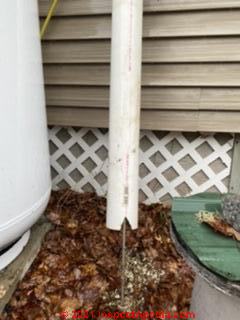 To be clear, what the “cylinder” I’m asking about is the slightly grey-colored one with the stone covering the tin top to it.
To be clear, what the “cylinder” I’m asking about is the slightly grey-colored one with the stone covering the tin top to it.
The white pvc (with the possible vermiculite under it) came out of that grey cylinder. Thanks
@John, another pic related to my question below. Thank you
Not sure if the picture I’m trying load is visible. I’m trying to find out what the tube going into the ground in the picture is.
I does not seem to serve an obvious function from what I can see. The inside of the cylinder has insulation inside of it adheres to it (fiberglass I think). When I removed the pvc tube inside of it, I can now see that some material fell out of it (a handful or so).
I’m questioning if it may be vermiculite. It’s outdoors.
I’d like to remove it so that it doesn’t get tracked in with the dogs.
I was thinking to wet the area a bit and then place the material in a garbage bag.
I’m not sure of best disposal site but I can leave the sealed bag in garage until I can determine that. - On 2021-11-13 by John - I
On 2021-11-13 by (mod) - Shallow Well Insulation: effort to protect shallow well access from freezing?
@John,
Thank you for an interesting insulation-identity question and the photos of the mystery “gray cylinder” in your yard and insulation you found therein. That looks like a shallow water well, perhaps with insulation to permit efforts to pump water from the well even in freezing water.
About the insulation:
I can’t see much but whatever the material is, if it’s that spilled material around the bottom of what looks like a white PVC pipe surrounding a metal rod or pipe, it looks like a very small amount of material that might simply be gently swept into a garbage bag and put out with your trash.
(A large amount of waste insulation might, in some communities, be disposed-of as construction waste).
INSULATION IDENTIFICATION GUIDE
includes photos of just about every type of building and mechanical systems insulation; those will help you identify what insulation you see.
If you think the insulation material is vermiculite, you may know that some (not all) vermiculite contains asbestos - the reason you’re asking about this in the first place.
HOW TO IDENTIFY VERMICULITE INSULATION
About that gray cylinder with green plywood top and cover stone:
1. What is that mystery gray cylinder?
Understanding the purpose of your mystery "cylinder" may be important.
2. What are the components being insulated?
From just the photo I can't say what is that gray cylinder with green-painted delaminating plywood "cover" held in place by a stone nor can I say what insulation material was used or why, though often insulation used outdoors shows a concern for freezing, such as a water pipe access or control.
Are you in a freezing climate?
Let's look further.
When we’re faced with the mystery of what’s inside an access opening like the one in your photo, and considering that most of our readers are smart but are also often unfamiliar with the topic of their question, I remember the Wise Lady from Philadelphia ( Lucretia P. Hale's - the Peterkin Papers) who would tell us what to do about the questions just posed:
LIFT OFF THE COVER AND LOOK into the opening, take a photo, using flash if needed, and SHOW US what you see.
Perhaps it's an access opening to operate or to inspect a building system or component like drainage or water supply.
Thank you again for a helpful question. Do post photos of what you find inside.Illustration: The Peterkin Papers and the Wise Lady from Philadelphia - discussed below
Consult the Wise Lady from Philadelphia
Illustrated above in this discussion is our adaptation of an antique copy of the back cover of Hale’s Peterkin Papers illustrates the benefit of trying something straight-forward when faced with a puzzle.
When the Peterkin’s piano was delivered it was set into the living room with the keyboard against the wall.
The Peterkins might have installed or opened an existing window to permit playing the piano from outside but in cold weather that wasn’t much fun and special fingerless gloves would be needed, and the home's heating bills would skyrocket - a contemporary concern today as winter approaches and this winter's heating fuel costs are expected to rise significantly.
The Wise Lady from Philadelphia would offer the Peterkins a better solution. Turn the piano around and close the window.On 2021-11-13 by John - More photos of the access well: water at bottom
Ok thank you, I agree that there was an emphasis to insulate this thing. I just took a picture looking down the grey cylinder.
There is now water down there whereas before there was not. We had about 2 inches of rain yesterday and the tin cover for the pipe is and probably was never fully watertight. Thanks for you help
We have another well in the yard distance away that has the wires inside do you expect for a functioning well. Would you figure it’s safe to say that this shallow well is out of commission and probably not attached to the house plumbing?
On 2021-11-13 by Inspectapedia Com Moderator (mod) - abandon old un-used well - properly
@John,
That sounds reasonable;
You can take a look at your house plumbing, follow the water pipes; you should see pipes connected only to a line coming in from your in-use well.
And looking down into the "old well" you don't see any pipes exiting the well (below ground) nor do any above-ground pipes go into the building?
That'd be an answer too.
Then see WELL ABANDONMENT PROCEDUREOn 2021-11-13 by John - cylinder sounds like metal
@Inspectapedia Com Moderator,
I just looked at that cylinder a little better. It definitely hard and almost sounds like metal as I hit my ring to it.We have a well maybe 30 feet away which I know is connected to the house.
We had a recent plumbing issue, which led me to pull off the pvc tube in the picture.At that time (about a month a go, we were looking at bare ground (about 4 ft down, so I can’t see that as being a well.
I’m thinking that trying to put the tube back in as I found it is the best thing to do (and cleaning up the material on the ground).Although I don’t know what the cylinder is made of, any problems with it potentially containing asbestos? Thanks
This Q&A series was posted originally
at INSULATION INSPECTION & IMPROVEMENT
On 2021-11-13 by Inspectapedia Com Moderator (mod) - hard metal well casing won't be transite
@John,
Hard metal won't be transite. It wont' be nor contain asbestos.
On 2019-04-22 by Charlie What is the proper method to abandon a hand dug well in Fairfax County Virginia
What is the proper method to abandon a hand dug well in Fairfax County
On 2019-04-22 by (mod) - How to abandon a hand dug well in Virginia
Charlie,
Typically a dug well is abandoned by filling the hole with clean rubble and soil.For detailed questions about abandoning your dug well you can of course contact the Fairfax County Division of Environmental Health directly at the Fairfax County Environmental Health Services office, 10777 Main Street, Fairfax VA 22030 Email: hdehd@fairfaxcounty.gov Tel: 703-246-2201 - TTY 711
But first take a look at this
- VIRGINIA LAW on WATER WELL ABANDONMENT [PDF] Virginia Law, Administrative Code 12VAC5-630-450. Well abandonment., Statutory Authority §§ 32.1-12 and 32.1-176 of the Code of Virginia. original source: https://law.lis.virginia.gov/admincode/title12/agency5/chapter630/section450/
where you can read the details of what Virginia law requires when abandoning a well.
Below we excerpt portions of the Virginia code that appear to pertain to your case of abandoning a dug well in Fairfax County.
Watch out: The requirements are different from the procedure for abandoning a drilled well using a well casing.
Virginia Law on How to Abandon a Well
A. Well abandonment is governed jointly by the Department of Environmental Quality and the Department of Health pursuant to § 62.1-44.92(6) of the Ground Water Act of 1973 (Repealed). In addition, the abandonment of any private well governed by this chapter, or any private well abandoned as a condition of a permit issued under this chapter, shall be administered by the Department of Health in conformance with this section.
B. A temporarily abandoned well shall be sealed with a water-tight cap or well head seal. Such a well shall be maintained so that it will not be a source or channel for contamination to ground water during temporary abandonment.
C. Permanent abandonment. The object of proper permanent abandonment is to prevent contamination from reaching ground water resources via the well. A permanently abandoned well shall be abandoned in the following manner:
1. All casing material may be salvaged.
2. Before the well is plugged, it shall be checked from land surface to the entire depth of the well to ascertain freedom from obstructions that may interfere with plugging (sealing) operations.
3. The well shall be thoroughly chlorinated prior to plugging (sealing).
4. Bored wells and uncased wells shall be backfilled with clean fill to the water level. A two-foot-thick bentonite plug shall be placed immediately above the water level. Clean fill shall be placed on top of the bentonite plug and brought up to at least five feet from the ground surface.
The top five feet of the well casing, if present, shall be removed from the bore hole. If an open annular space is present around the well casing, the annular space shall be filled with grout to the maximum depth possible, but less than or equal to 20 feet.
A one-foot-thick cement or bentonite grout plug that completely fills the bore void space shall be placed a minimum of five feet from the ground surface.
The remaining space shall be filled with clean fill which is mounded a minimum of one foot above the surrounding ground surface. Bored wells or uncased wells abandoned in this manner shall be treated as wells with respect to determining the minimum separation distance to sources of contamination listed in Table 3.1.
The location of these wells shall be permanently marked for future location.
5. Wells constructed in collapsing material shall be completely filled with grout or clay slurry by introduction through a pipe initially extending to the bottom of the well. Such pipe shall be raised, but remain submerged in grout, as the well is filled.
6. Wells constructed in consolidated rock formations or which penetrate zones of consolidated rock may be filled with sand or gravel opposite the zones of consolidated rock. The top of the sand or gravel fill shall be at least five feet below the top of the consolidated rock and at least 20 feet below land surface. The remainder of the well shall be filled with grout or clay slurry.
7. Other abandonment procedures may be approved by the division on a case by case basis.
8. Test and exploration wells shall be abandoned in such a manner to prevent the well from being a channel for the vertical movement of water or a source of contamination to ground water.
9. When bored wells are bored and a water source is not found, and the casing has not been placed in the bore hole, the bore hole may be abandoned by backfilling with the bore spoils to at least five feet below the ground surface. A two-feet-thick bentonite grout plug shall be placed at a minimum of five feet from the ground surface.
The remainder of the bore hole shall be filled with the bore spoils.
On 2015-04-23 by Robert Smith
How to fill in an old hand dug water well, located very close to house and situated in a sheltered structure.
On 2015-05-18 by (mod)
Robert
Why not fill the well with stone rubble and follow the well abandonment procedures given in the expert sources above on this page?
Thank you to our readers for their generous comments
On 2015-09-23 by Durandana
Hello, and thank you very much for sharing this information on how to properly abandon a well.
Many times this step goes undone as you think it wont be a problem, especially if it's on private land. I think it's always good to be responsible and to abandon wells in the proper way.
On 2015-09-23 by (mod)
Thanks Beaman Well Drilling for the comment.
Our system and policy don't permit commenters to post links and ads but if you contribute even the smallest suggestion, content, or correction to InspecApedia.com we are happy to cite and link to contributors.
...
Continue reading at WELLS CISTERNS & SPRINGS - home, or select a topic from the closely-related articles below, or see the complete ARTICLE INDEX.
Or see these
Recommended Articles
- DUG WELL SAFETY WALLS & COVERS
- SEPTIC TANK ABANDONMENT GUIDE
- WELL CONSTRUCTION & MAINTENANCE
- WELL SAFETY WALL & COVER
- WELLS CISTERNS & SPRINGS - home
Suggested citation for this web page
WELL ABANDONMENT PROCEDURE at InspectApedia.com - online encyclopedia of building & environmental inspection, testing, diagnosis, repair, & problem prevention advice.
Or see this
INDEX to RELATED ARTICLES: ARTICLE INDEX to WATER SUPPLY, PUMPS TANKS WELLS
Or use the SEARCH BOX found below to Ask a Question or Search InspectApedia
Ask a Question or Search InspectApedia
Try the search box just below, or if you prefer, post a question or comment in the Comments box below and we will respond promptly.
Search the InspectApedia website
Note: appearance of your Comment below may be delayed: if your comment contains an image, photograph, web link, or text that looks to the software as if it might be a web link, your posting will appear after it has been approved by a moderator. Apologies for the delay.
Only one image can be added per comment but you can post as many comments, and therefore images, as you like.
You will not receive a notification when a response to your question has been posted.
Please bookmark this page to make it easy for you to check back for our response.
IF above you see "Comment Form is loading comments..." then COMMENT BOX - countable.ca / bawkbox.com IS NOT WORKING.
In any case you are welcome to send an email directly to us at InspectApedia.com at editor@inspectApedia.com
We'll reply to you directly. Please help us help you by noting, in your email, the URL of the InspectApedia page where you wanted to comment.
Citations & References
In addition to any citations in the article above, a full list is available on request.
- Akgün, H. "An assessment of borehole sealing performance in a salt environment." Environmental Geology 31, no. 1-2 (1997): 34-41.
- Barclay, Ian, Jan Pellenbarg, Frans Tettero, Jochen Pfeiffer, Harold Slater, Timo Staal, David Stiles, Geoff Tilling, and Chris Whitney. "The beginning of the end: a review of abandonment and decommissioning practices." Oilfield Review 13, no. 4 (2001): 28-41.
- Brush, Richard E. "Wells Construction. Hand Dug and Hand Drilled. Appropriate Technologies for Development. Manual M-9." (1982).
- Cunningham, Alfred B., Ellen Lauchnor, Joe Eldring, Richard Esposito, Andrew C. Mitchell, Robin Gerlach, Adrienne J. Phillips, Anozie Ebigbo, and Lee H. Spangler. "Abandoned well CO2 leakage mitigation using biologically induced mineralization: current progress and future directions." Greenhouse Gases: Science and Technology 3, no. 1 (2013): 40-49.
- Escolero, O. A., L. E. Marin, B. Steinich, A. J. Pacheco, S. A. Cabrera, and J. Alcocer. "Development of a protection strategy of karst limestone aquifers: the Merida Yucatan, Mexico case study." Water Resources Management 16, no. 5 (2002): 351-367.
- Gass, Tyler E., Jay H. Lehr, and Harold W. Heiss. Impact of abandoned wells on ground water. Environmental Protection Agency, Office of Research and Development, Robert S. Kerr Environmental Research Laboratory, 1977.
- Handbook of suggested practices for the design and installation of ground-water monitoring wells. National Water Well Association, 1989.
- Hou, Zhengmeng, Lars Wundram, Robert Meyer, Meinhardt Schmidt, Steffen Schmitz, and Patrick Were. "Development of a long-term wellbore sealing concept based on numerical simulations and in situ-testing in the Altmark natural gas field." Environmental Earth Sciences 67, no. 2 (2012): 395-409.
- Jimenez, J. A., and R. J. Chalaturnyk. "SPE/ISRM 78196." (2002).
- Kansas DOH: "How do I Plug a Dug Well - Fact Sheet", Kansas Department of Heatlh and Environment, - retrieved 31 Jan 2015 original source: http://www.kdheks.gov/waterwell/down
- Kopp, Andreas, Philip John Binning, K. Johannsen, R. Helmig, and H. Class. "A contribution to risk analysis for leakage through abandoned wells in geological CO 2 storage." Advances in Water Resources 33, no. 8 (2010): 867-879.
- Lapham, Wayne W., Franceska D. Wilde, and Michael T. Koterba. Guidelines and standard procedures for studies of ground-water quality: selection and installation of wells, and supporting documentation. US Department of the Interior, US Geological Survey, 1997.
- Mainguy, M., P. Longuemare, A. Audibert, and E. Lécolier. "Analyzing the risk of well plug failure after abandonment." Oil & Gas Science and Technology-Revue de l'IFP 62, no. 3 (2007): 311-324.
- Nagelhout, A. C. G., M. G. R. Bosma, P. J. Mul, G. G. Krol, J. F. G. van Velzen, J. S. Joldersma, S. G. James, B. Dargaud, G. J. R. Schreuder, and F. Théry. "Laboratory and Field Validation of a Sealant System for Critical Plug-and-Abandon Situations." SPE drilling & completion 25, no. 3 (2010): 314.
- Preston, C., M. Monea, W. Jazrawi, K. Brown, S. Whittaker, D. White, D. Law, R. Chalaturnyk, and B. Rostron. "IEA GHG Weyburn CO 2 monitoring and storage project." Fuel Processing Technology 86, no. 14 (2005): 1547-1568.
- Scherer, George W., Michael A. Celia, Jean-Herve Prevost, S. Bachu, R. Bruant, A. Duguid, R. Fuller, S. E. Gasda, M. Radonjic, and W. Vichit-Vadakan. "Leakage of CO2 through abandoned wells: Role of corrosion of cement." Carbon Dioxide Capture for Storage in Deep Geologic Formations 2 (2005): 827-848.
- Washington State DOE, "Abandoned Wells, Problems and Solutions", Washington State Department of Ecology, POB 46600 Olymnpia WA 98504, retrieved 31 Jan 2015, original source: https://fortress.wa.gov/ecy/publications/publications/96br097.pdf
- Washington State DOE, "Decomissioning of Abandoned Wells", Washington State Department of Ecology, retrieved 31 Jan 2015, original source: http://www.ecy.wa.gov/programs/wr/wells/abandon-wells.html
- In addition to citations & references found in this article, see the research citations given at the end of the related articles found at our suggested
CONTINUE READING or RECOMMENDED ARTICLES.
- Carson, Dunlop & Associates Ltd., 120 Carlton Street Suite 407, Toronto ON M5A 4K2. Tel: (416) 964-9415 1-800-268-7070 Email: info@carsondunlop.com. Alan Carson is a past president of ASHI, the American Society of Home Inspectors.
Thanks to Alan Carson and Bob Dunlop, for permission for InspectAPedia to use text excerpts from The HOME REFERENCE BOOK - the Encyclopedia of Homes and to use illustrations from The ILLUSTRATED HOME .
Carson Dunlop Associates provides extensive home inspection education and report writing material. In gratitude we provide links to tsome Carson Dunlop Associates products and services.


